2005 FORD GT weight
[x] Cancel search: weightPage 58 of 200
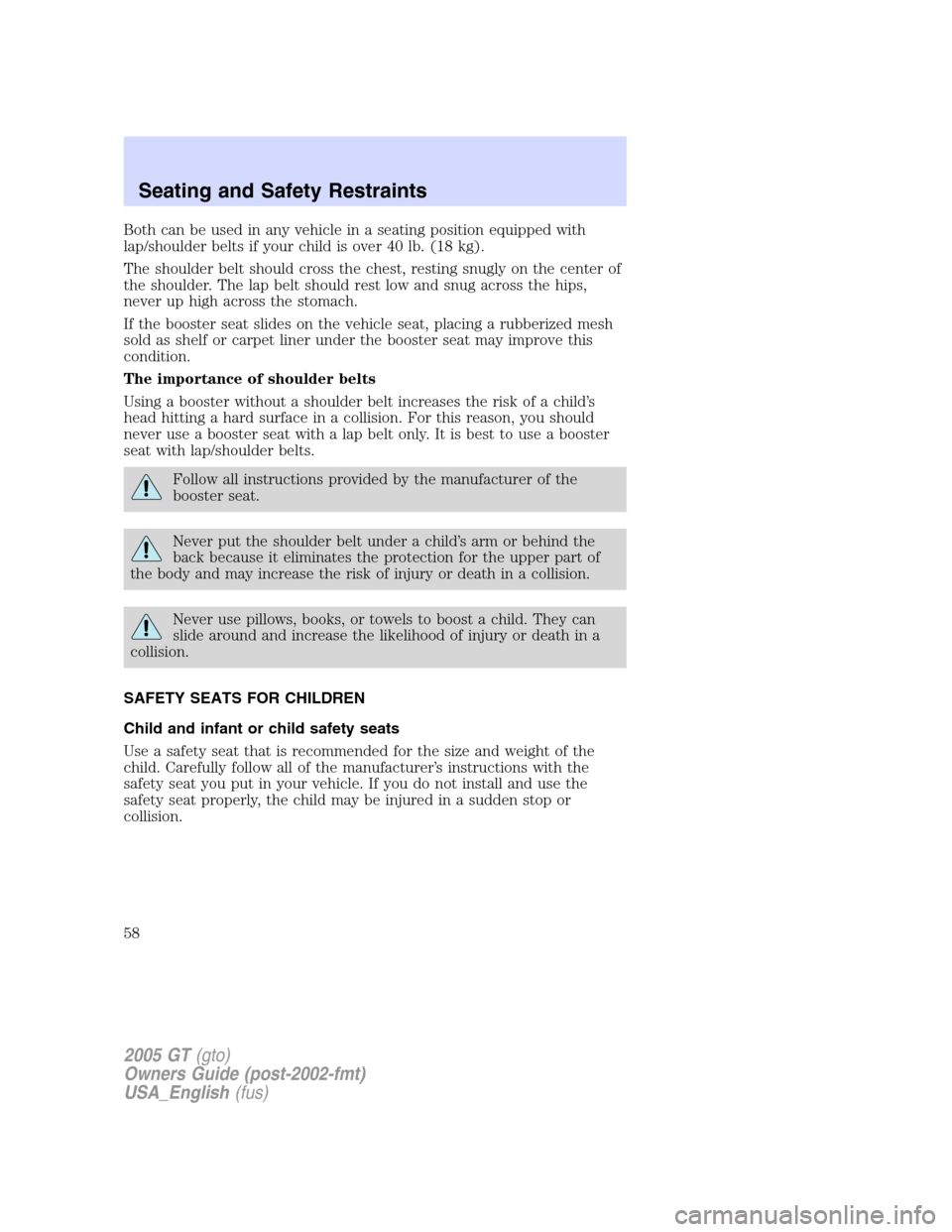
Both can be used in any vehicle in a seating position equipped with
lap/shoulder belts if your child is over 40 lb. (18 kg).
The shoulder belt should cross the chest, resting snugly on the center of
the shoulder. The lap belt should rest low and snug across the hips,
never up high across the stomach.
If the booster seat slides on the vehicle seat, placing a rubberized mesh
sold as shelf or carpet liner under the booster seat may improve this
condition.
The importance of shoulder belts
Using a booster without a shoulder belt increases the risk of a child’s
head hitting a hard surface in a collision. For this reason, you should
never use a booster seat with a lap belt only. It is best to use a booster
seat with lap/shoulder belts.
Follow all instructions provided by the manufacturer of the
booster seat.
Never put the shoulder belt under a child ’s arm or behind the
back because it eliminates the protection for the upper part of
the body and may increase the risk of injury or death in a collision.
Never use pillows, books, or towels to boost a child. They can
slide around and increase the likelihood of injury or death in a
collision.
SAFETY SEATS FOR CHILDREN
Child and infant or child safety seats
Use a safety seat that is recommended for the size and weight of the
child. Carefully follow all of the manufacturer ’s instructions with the
safety seat you put in your vehicle. If you do not install and use the
safety seat properly, the child may be injured in a sudden stop or
collision.
2005 GT(gto)
Owners Guide (post-2002-fmt)
USA_English (fus)
Seating and Safety Restraints
58
Page 67 of 200

The traction grade assigned to this tire is based on
straight-ahead braking traction tests, and does not include
acceleration, cornering, hydroplaning or peak traction characteristics.
Temperature A B C
The temperature grades are A (the highest), B and C, representing the
tire ’s resistance to the generation of heat and its ability to dissipate heat
when tested under controlled conditions on a specified indoor laboratory
test wheel. Sustained high temperature can cause the material of the tire
to degenerate and reduce tire life, and excessive temperature can lead to
sudden tire failure. The grade C corresponds to a level of performance
which all passenger car tires must meet under the Federal Motor Vehicle
Safety Standard No. 109. Grades B and A represent higher levels of
performance on the laboratory test wheel than the minimum required by
law.
The temperature grade for this tire is established for a tire that
is properly inflated and not overloaded. Excessive speed,
underinflation, or excessive loading, either separately or in
combination, can cause heat buildup and possible tire failure.
TIRES
Tires are designed to give many thousands of miles of service, but they
must be maintained in order to get the maximum benefit from them.
Glossary of tire terminology
• Tire label: A label showing the OE (Original Equipment) tire sizes,
recommended inflation pressure and the maximum weight the vehicle
can carry.
• Tire Identification Number (TIN): A number on the sidewall of
each tire providing information about the tire brand and
manufacturing plant, tire size and date of manufacture.
• Inflation pressure: A measure of the amount of air in a tire.
• Standard load: A class of P-metric or Metric tires designed to carry a
maximum load at 35 psi [37 psi (2.5 bar) for Metric tires]. Increasing
the inflation pressure beyond this pressure will not increase the tire ’s
load carrying capability.
2005 GT(gto)
Owners Guide (post-2002-fmt)
USA_English (fus)
Tires, Wheels and Loading
67
Page 80 of 200

INFORMATION CONTAINED ON THE TIRE SIDEWALL
Federal law requires tire manufacturers to place standardized
information on the sidewall of all tires. This information identifies and
describes the fundamental characteristics of the tire and also provides a
U.S. DOT Tire Identification Number for safety standard certification and
in case of a recall.
Information on “P” type tires
P215/65R15 95H is an example of a
tire size, load index and speed
rating. The definitions of these
items are listed below. (Note that
the tire size, load index and speed
rating for your vehicle may be
different from this example.)
1.P: Indicates a tire, designated by
the Tire and Rim Association
(T&RA), that may be used for
service on cars, SUVs, minivans and
light trucks.
Note: If your tire size does not
begin with a letter this may mean it
is designated by either ETRTO
(European Tire and Rim Technical Organization) or JATMA (Japan Tire
Manufacturing Association).
2. 215: Indicates the nominal width of the tire in millimeters from
sidewall edge to sidewall edge. In general, the larger the number, the
wider the tire.
3. 65: Indicates the aspect ratio which gives the tire ’s ratio of height to
width.
4. R: Indicates a “radial ”type tire.
5. 15: Indicates the wheel or rim diameter in inches. If you change your
wheel size, you will have to purchase new tires to match the new wheel
diameter.
6. 95: Indicates the tire ’s load index. It is an index that relates to how
much weight a tire can carry. You may find this information in your
Owner ’s Guide. If not, contact a local tire dealer.
Note: You may not find this information on all tires because it is not
required by federal law.
2005 GT(gto)
Owners Guide (post-2002-fmt)
USA_English (fus)
Tires, Wheels and Loading
80
Page 86 of 200
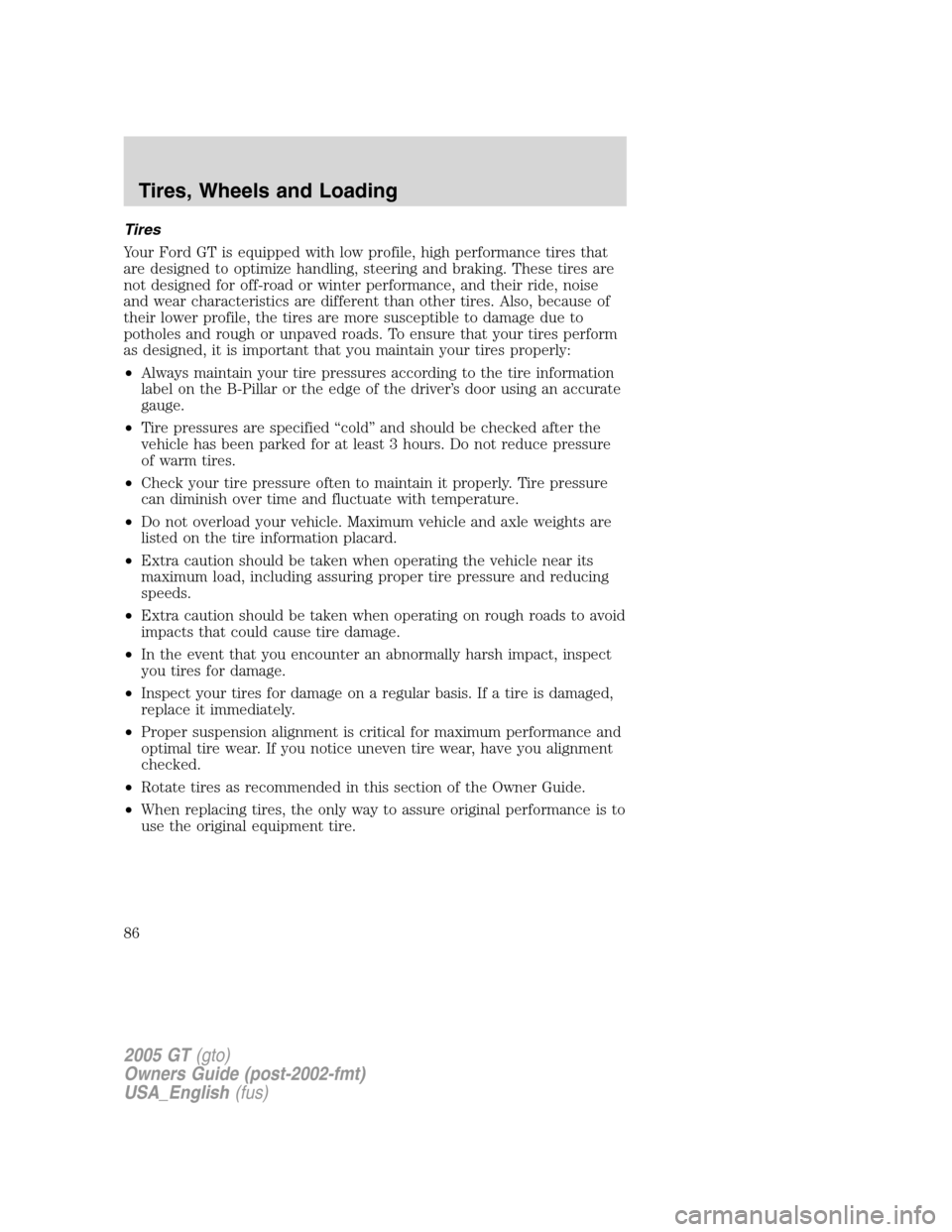
Tires
Your Ford GT is equipped with low profile, high performance tires that
are designed to optimize handling, steering and braking. These tires are
not designed for off-road or winter performance, and their ride, noise
and wear characteristics are different than other tires. Also, because of
their lower profile, the tires are more susceptible to damage due to
potholes and rough or unpaved roads. To ensure that your tires perform
as designed, it is important that you maintain your tires properly:
•Always maintain your tire pressures according to the tire information
label on the B-Pillar or the edge of the driver ’s door using an accurate
gauge.
• Tire pressures are specified “cold ”and should be checked after the
vehicle has been parked for at least 3 hours. Do not reduce pressure
of warm tires.
• Check your tire pressure often to maintain it properly. Tire pressure
can diminish over time and fluctuate with temperature.
• Do not overload your vehicle. Maximum vehicle and axle weights are
listed on the tire information placard.
• Extra caution should be taken when operating the vehicle near its
maximum load, including assuring proper tire pressure and reducing
speeds.
• Extra caution should be taken when operating on rough roads to avoid
impacts that could cause tire damage.
• In the event that you encounter an abnormally harsh impact, inspect
you tires for damage.
• Inspect your tires for damage on a regular basis. If a tire is damaged,
replace it immediately.
• Proper suspension alignment is critical for maximum performance and
optimal tire wear. If you notice uneven tire wear, have you alignment
checked.
• Rotate tires as recommended in this section of the Owner Guide.
• When replacing tires, the only way to assure original performance is to
use the original equipment tire.
2005 GT(gto)
Owners Guide (post-2002-fmt)
USA_English (fus)
Tires, Wheels and Loading
86
Page 89 of 200

SNOW TIRES
The original equipment tires on your Ford GT are designed for maximum
performance in dry and wet conditions. They are not designed for winter
use on ice or snow and cannot be used with snow chains or other tire
mounted traction aid devices.
TRAILER TOWING
Your vehicle is not equipped to tow. No towing packages are available
through Ford or Lincoln/Mercury dealers.
VEHICLE LOADING
This section will guide you in the proper loading of your vehicle and/or
trailer, to keep your loaded vehicle weight within its design rating
capability. Properly loading your vehicle will provide maximum return of
vehicle design performance. Before loading your vehicle, familiarize
yourself with the following terms for determining your vehicle’s weight
ratings from the vehicle ’s Safety Certification Label and Tire Label:
Base Curb Weight –is the weight of the vehicle including a full tank of
fuel and all standard equipment. It does not include passengers, cargo, or
optional equipment.
Vehicle Curb Weight –is the weight of your new vehicle when you
picked it up from your dealer plus any aftermarket equipment.
2005 GT(gto)
Owners Guide (post-2002-fmt)
USA_English (fus)
Tires, Wheels and Loading
89
Page 90 of 200
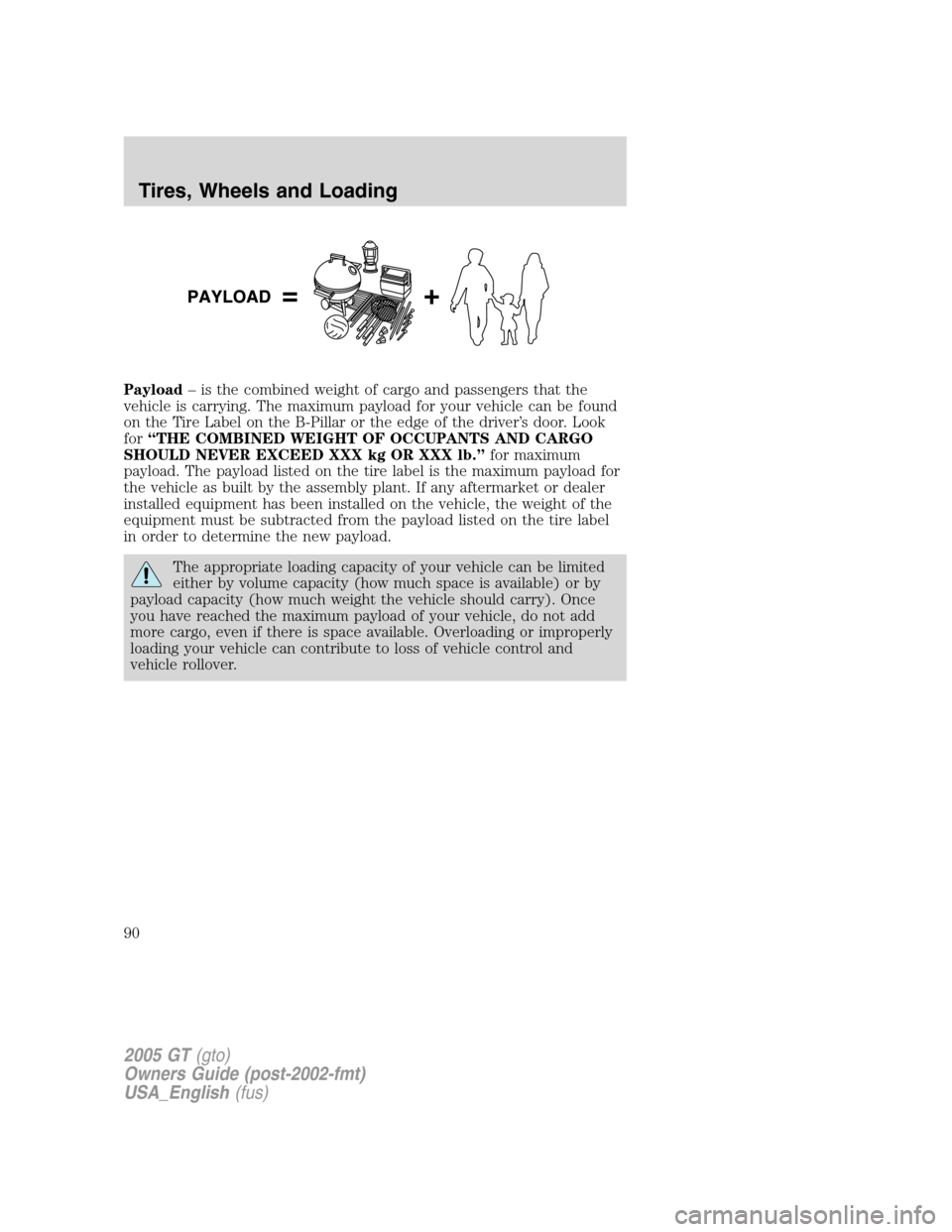
Payload–is the combined weight of cargo and passengers that the
vehicle is carrying. The maximum payload for your vehicle can be found
on the Tire Label on the B-Pillar or the edge of the driver ’s door. Look
for “THE COMBINED WEIGHT OF OCCUPANTS AND CARGO
SHOULD NEVER EXCEED XXX kg OR XXX lb. ”for maximum
payload. The payload listed on the tire label is the maximum payload for
the vehicle as built by the assembly plant. If any aftermarket or dealer
installed equipment has been installed on the vehicle, the weight of the
equipment must be subtracted from the payload listed on the tire label
in order to determine the new payload.
The appropriate loading capacity of your vehicle can be limited
either by volume capacity (how much space is available) or by
payload capacity (how much weight the vehicle should carry). Once
you have reached the maximum payload of your vehicle, do not add
more cargo, even if there is space available. Overloading or improperly
loading your vehicle can contribute to loss of vehicle control and
vehicle rollover.
2005 GT(gto)
Owners Guide (post-2002-fmt)
USA_English (fus)
Tires, Wheels and Loading
90
Page 91 of 200
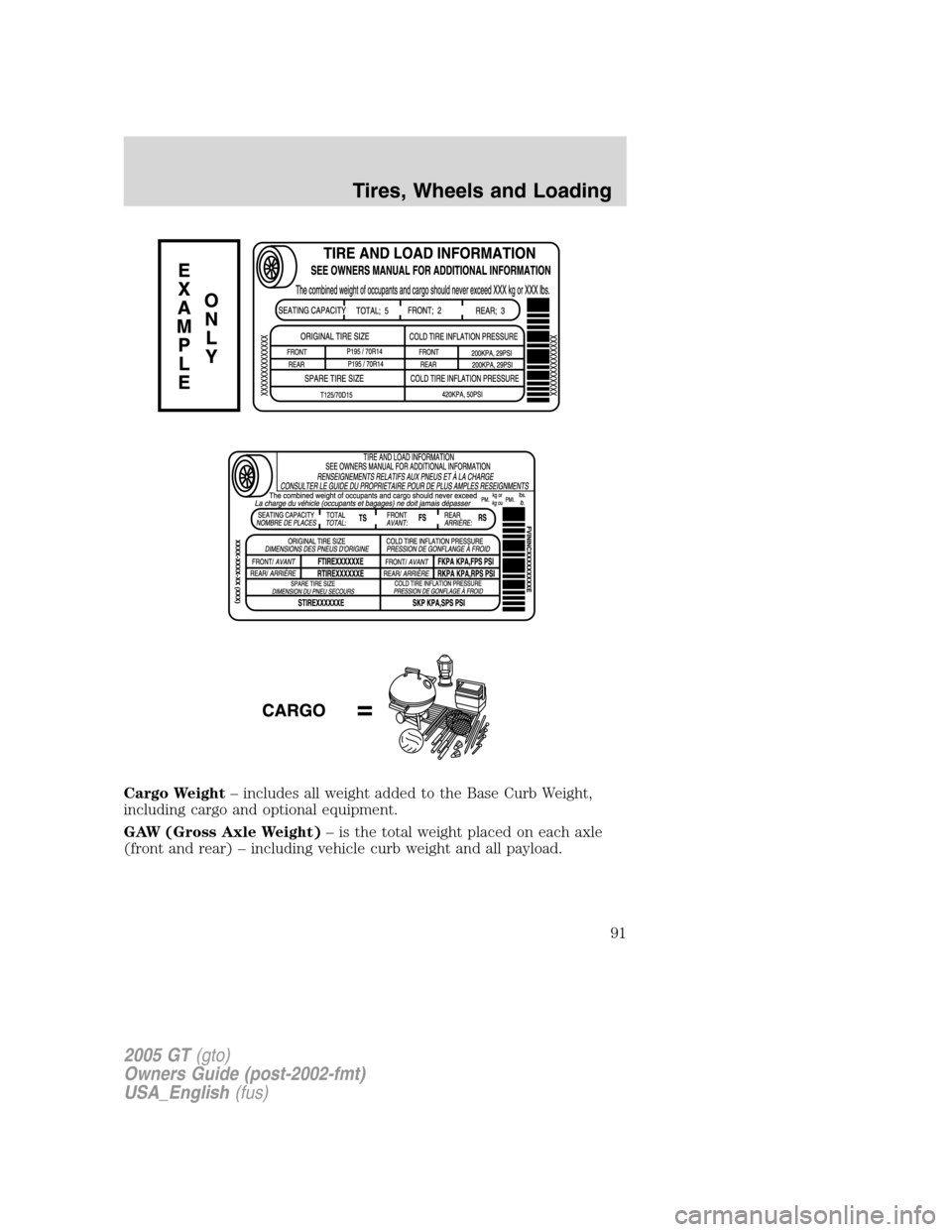
Cargo Weight–includes all weight added to the Base Curb Weight,
including cargo and optional equipment.
GAW (Gross Axle Weight) –is the total weight placed on each axle
(front and rear) –including vehicle curb weight and all payload.
2005 GT(gto)
Owners Guide (post-2002-fmt)
USA_English (fus)
Tires, Wheels and Loading
91
Page 92 of 200
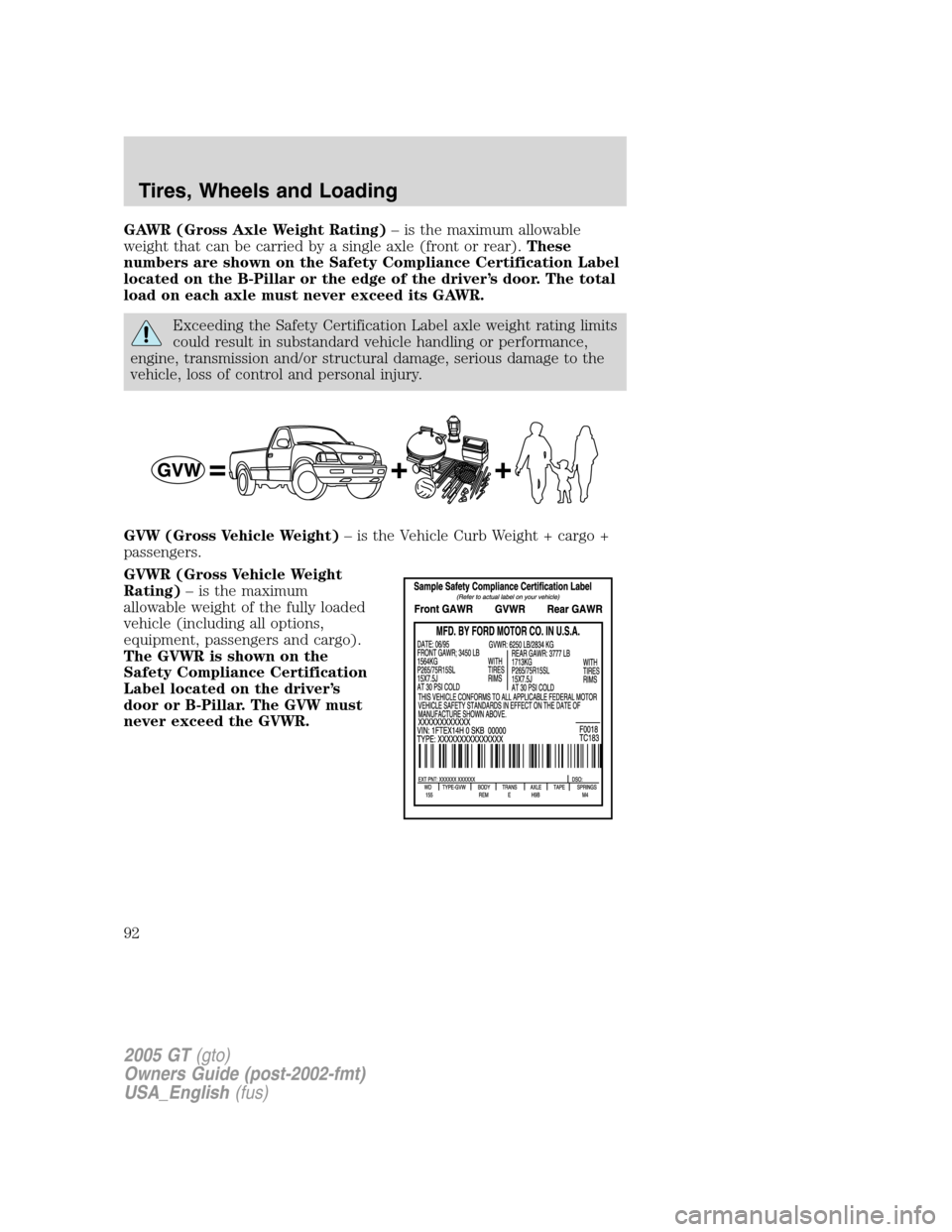
GAWR (Gross Axle Weight Rating)–is the maximum allowable
weight that can be carried by a single axle (front or rear). These
numbers are shown on the Safety Compliance Certification Label
located on the B-Pillar or the edge of the driver ’s door. The total
load on each axle must never exceed its GAWR.
Exceeding the Safety Certification Label axle weight rating limits
could result in substandard vehicle handling or performance,
engine, transmission and/or structural damage, serious damage to the
vehicle, loss of control and personal injury.
GVW (Gross Vehicle Weight) –is the Vehicle Curb Weight + cargo +
passengers.
GVWR (Gross Vehicle Weight
Rating) –is the maximum
allowable weight of the fully loaded
vehicle (including all options,
equipment, passengers and cargo).
The GVWR is shown on the
Safety Compliance Certification
Label located on the driver ’s
door or B-Pillar. The GVW must
never exceed the GVWR.
2005 GT(gto)
Owners Guide (post-2002-fmt)
USA_English (fus)
Tires, Wheels and Loading
92